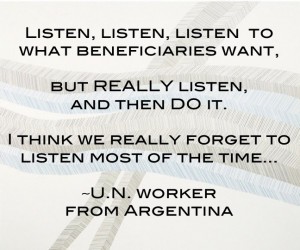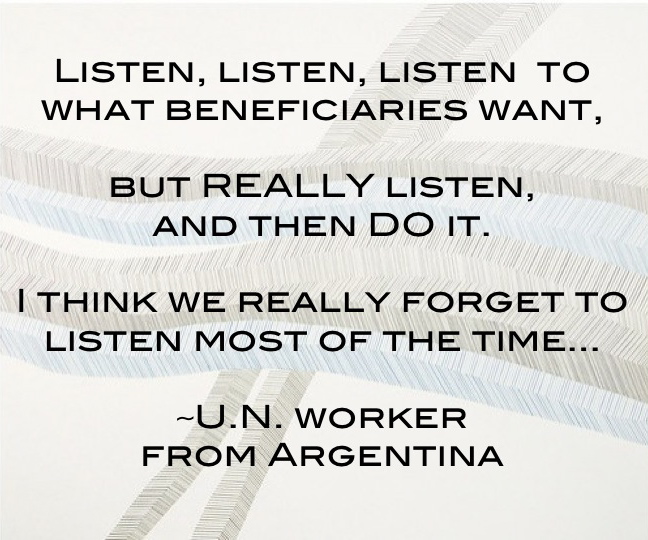“‘The system’ whereby foreign donors give handouts, and not sustainable initiatives that are drawn from the needs of the communities, is a problem.” ~R.F.M., Zimbabwe
This post is a continuation of the small series I started in August entitled “Changing the System,” which pulls together quotations from about 150 of my former colleagues, friends, and acquaintances around the world who responded to the question I sent out earlier this year when I started how-matters.org:
If you personally could do one thing to change “the system” of foreign aid and development assistance, what would you do? (See post “A Question Resonates”)
My interest is in surfacing issues and solutions from different voices about the way forward in development policy and practice. Think of this as my own informal mini-Listening Project, though without the research framework.
This set of ideas is grouped around a theme of “from the ground up.” As you review these ideas on what to address (and sometimes how), consider the following questions and please include a comment answering:
1) What could have the most impact?
2) Which is most feasible?
3) Which idea is most unrealistic and why?
Now is the time to be corrective, restorative, and imaginative, with imperative and profound effect. Let’s get serious about how we will transform the development industry and generate the next steps to fix these problems that continue to plague us and perplex us.
***
1) Whose priorities?
I would change the system of support on basis on donor priorities to that of beneficiaries priorities. ~M.M., Malawi
I would ensure that recipients of any assistance are involved in defining the forms and nature of assistance that reach them, rather than just being targets of aid. ~I.M., Zimbabwe
Recently a community was able to raise enough internal money for a generator, electric keyboard, speaker system and they regular petrol requirements to keep the whole thing running while they wait for a donor to provide a well so they don’t have to walk 7km to the nearest unclean water source. What the community gave for the whole sound system was enough to have paid for a well to be dug, outfitted and maintained for a while. The community is banking on the fact that someone from the outside will pay for a well, but they know they won’t get funds for the party equipment. ~H.L., U.S.
Get rid of most of the programmatic restricted funding and allow communities to identify their own priorities. ~D.K., South Africa
2) Who’s really in the driver’s seat?
Let the intended beneficiaries of development take the driving seat from identifying their only priority developmental issues, to planning, designing, implementing and monitoring. Let the beneficiaries define the priorities and let the donors be accountable to beneficiaries for quality, appropriateness or adequacy of the assistance delivered. ~C.D., Swaziland
I have realised that the whole line up from a community facilitator up to the chief executives of big corporate NGOs—the master served is not the person who needs the support but the one who gives the support. I would re-wire the system and turn it the other way round. ~E.M., Mozambique
I would make the system bottom up – make INGOs more accountable to the needs of communities rather than the other way around. Have INGOs base their funding agendas on what communities tell them. ~J. B., Zimbabwe
The so-called development assistance: whose interest is given priority–the people? the government? the donor? Development assistance must be [centered on] people’s needs rather than the political agenda, which is happening under the table… The system must avoid the intermediaries that bring the money back home. Let it focus on utilizing local resources. The system must [prioritize] people’s potential to change their lives, not donors’ money. ~M.G., Ethiopia
I would ask the beneficiaries what is that they want…Why should current USAID be made up and enforced by a group of people that never leave their desks? That never leave the United States? Plain and simple – listen to the people they know what they need, not some suit drinking Starbucks in his cubicle. ~D.S., Palestine
3) Who’s most in need?
Most aid does not actually go to the poorest that needs it most. There are a lot of people and organizations that are actually and seriously in need of foreign aid to assist them to sustain themselves, but it has never been easy to have access. I truly believe that if the aid goes direct to the people who need it most, who are the most vulnerable, mostly for education, shelter, nutrition etc, then things will change from generation to generation. The rich don’t even need this aid, but they are the ones who are benefitting from it and the poor comes last. ~E.M., South Africa
On what can be done to change the systems of aid, I think the most important thing is the improve[ment] of wellbeing of ultra poor people from the rural communities, so that they can remain within their birth places. ~E.M., Malawi
The foreign aid system needs to find ways of reaching out to the poor of the poorest in the remote rural areas. One way is to ask people to recommend projects that are in remote rural areas, and to look for local volunteers to assist the illiterate folks doing the development work. ~D.D., South Africa
4) Invest in local organizations.
Let the foreign aid and development assistance go directly to the grassroots organizations. This is the only way such assistance can reach the people it is intended for. ~F.N., Uganda
I would ask for improved level of resources to community and accountability of how resources are utilized on sustainable desired change. ~W.M., Kenya
I work primarily with local nonprofits that would benefit tremendously from a relationship with USAID, but they can’t even get in the door! It’s frustrating. And the contractors really aren’t interested in what is actually happening in the field. They just want to check off deliverables that have been established in some conference room in Washington DC. Why can’t local groups benefit directly from direct foreign aid? ~A.M., U.S.
ldentify grassroots organisations with grassroots structures and sustainable home grown empowerment models, support them and build their capacity until such a time they can operate as NGOs or national movements. ~S.C., Zimbabwe
I would like to encourage foreign aid agencies to invest in WOMEN and help them to strengthen their organizations. Do so with lots of grassroots organisations. It is time for indigenous, local organisations to take care of their own problems… ~T.T., South Africa
***
Related Posts
Changing the aid system: 5 more ideas from the inside
Listening to People on the Receiving End of Aid


Pingback: Tweets that mention How Matters / Changing the system…from the ground up -- Topsy.com
I would change the system of support on basis on donor priorities to:
Be for the community
Live among them
Learn from them and with them
Plan with them
Work with them
Starting with what they know
Building on what they have
Teach by showing, learn by doing
Not a showcase but a process
Not odds and ends but a system
Not piecemeal but an integrated approach
Not to conform but to transform
Recognize the uniqueness of the vernacular languages
And building on the community eloquence to address critical health issues such as HIV/GBV/WATSAN and economic empowerment
Develop professions, skills of the implementers and the community through practical field experiences.
Vuonze Patrick
GBV Officer
ARC International
South Sudan
A very interesting question, how to change the system. I work with a non-profit, Mary’s Pence, that is providing resources to women’s networks in Latin America to start their own lending pool. We know that access to money is important, that community and connection is important, and that women know what is needed in their communities. Mary’s Pence provides funds for the lending pool, which the women then own and manage (they determine who gets loans, and the terms and interest rates). They charge interest, which then goes to build the fund and pay a coordinator. They invest in small businesses that meet local needs. Because we are a small organization we know the women who receive the funds, and we accompany them on their journey though visits 3 times a year with Gilda, a Mexican woman with a history of working with refugees and small business women. We are working with networks in El Salvador, Guatemala, Nicaragua, Mexico and a r ecent addition, Haiti. You can see a 4 minute video about ESPERA Funds at (they http://www.maryspence.org/videos.html I’d be interested in knowing what people think. Katherine katherine@maryspence.org
718-720-8040
Pingback: What should be changed about foreign aid? « The Media Map Project
Coming from one of the poorest countries in the world Nepal, my opinion is not a different one to that of Arican experience. Major issues I see are: Donors are not only to blame for this anomaly.
Each consecutive governments talk of creating a priority-based project bank, but never materialize seeking project preparation technical assistance (PPTA) from the multilateral donors while accepting whatever comes across the bilateral donor communities irrespective of the country’s needs and priorities. Recipient governments need to be serious about it not just ‘talk’ of processing the matter.
The age-old donors’ notion that ‘we know your problem and priorities, accept what we consider works best to you’ should be removed by replacing the top-down by the bottom-up planning process in actual practice.
PROFILE OF OUR ORGANIZATION
1. Name Of Organization : PEOPLES AWARNESS AND LEGAL AID MOVEMENT (PALAM)
2. Address of the Organization : 23/1, PERIYANAYAKIPURAM,
THIRUTHURAIPOONDI-614713
THIRUVARUR DISTRICT.
TAMIL NADU, INDIA.
3. E.Mail : Palamsenthil@yahoo.com
Website : http://www.palamngo.org
MISSION
To create a world wide peace & harmony through welfare & Development activities without among any kind of discrimination of Religion, colour, gender, race and etc., the mission of the “PALAM” which is conscious of the concerned with liberation not oppression freedom not slavery, light not darkness health not disease, life not Death
COMMUNITY ORGANIZATION AND AWARENESS ENHANCEMENT IN
1. Natural Disaster relief and rehabilitation
2. Sustainable Agriculture
3. Environment Protection – Biodiversity Conservation – Tree Planting.
4. Organic Farming / Horticulture.
5. Vermin Compost Manure – Name Pesticide Usage
6. Alternate Crops – Pulses grams
7. Livelihood Restoration For Fisheries and Non-Fisheries
8. New Housing Construction and Renovation of old Houses.
9. Women Welfare living condition improvement micro fiancé.
10. Livelihood Trainings for SHGs.
11. Disability Rehabilitation
12. Computer Training education
13. Child and Women Development
14. Women Awareness Program
15. Aids Prevention Awareness program
16. Aids Vaccine Awareness program
17. Road Safety
18. Micro Finance for poor families food security and poverty alleviation.
19. Environmental Security.
Thanking You
Submitted by K.SENTHILKUMAR, Managing Trustee
I agree that it is important to have the beneficiaries design their projects and “be in the driver’s seat”. How do we communicate to our donors about the importance of using that as our grant model? We have to make it so the donors see that as the best way to promote development and empowerment.
A question came to mind: How do grants work in the U.S. Do community grant foundations here let the grant beneficiaries drive their projects? What can we learn from that?
Pingback: Shifting Perspectives | Spirit in Action